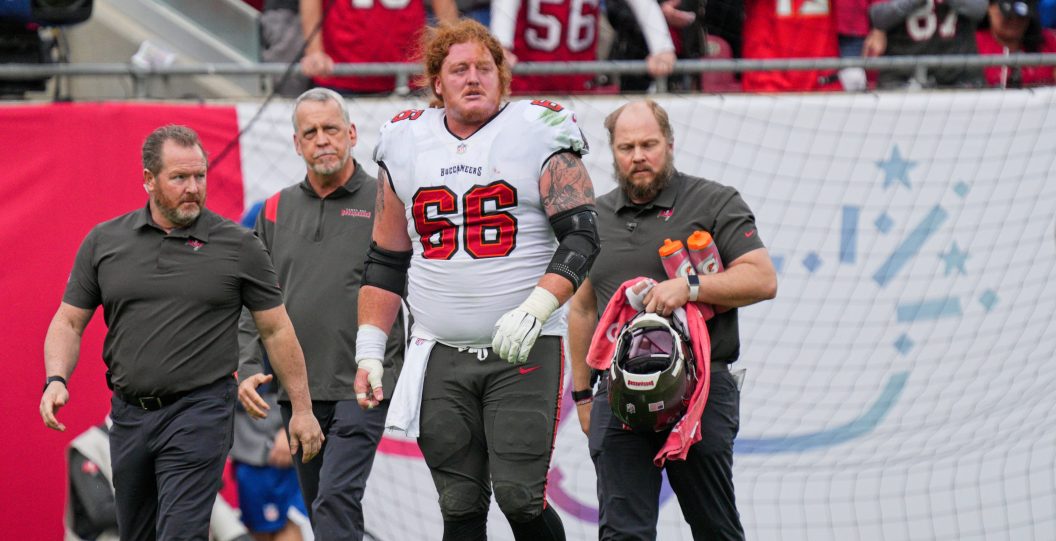Ryan Jensen did everything he could to play just one more time with Tom Brady, but it may have cost him the rest of his career.
Videos by FanBuzz
Jensen, the veteran center for the Tampa Bay Buccaneers, went on season-ending injured reserve last week after it was determined that his injured knee simply wasn't healing after last season's attempt at coming back.
Normally, knee injuries are pretty straightforward in the NFL. A player is carted off, gets an MRI and has surgery, and we see him next year after perhaps some occasional positive notes during the season, such as "John Doe is off his crutches and making progress." It's as rote as it gets. For Jensen, not one thing went normally.
The injury occurred early in training camp and didn't appear to be that complex. However, it turned out to be more than a simple sprain. In fact, several structures were involved.
But wait, even that gets complicated. Jensen told the media that he tore "all the ligaments, flipped the meniscus, and broke two bones." Jensen is many things but not a doctor or athletic trainer, and this is one of the risks of having players and coaches pass on medical information. Sometimes, they don't get everything right. What Jensen had was three sprained ligaments (ACL, MCL, PCL), a bucket-handle tear of the meniscus, and a fractured tibial head with some damage to the cartilage there.
Any one of those injuries is enough to cost time; but together, it's a complex mix. The ACL and fracture are the most serious, with ACL surgery often costing players nine to 12 months. MCL injuries often aren't fixed — there are secondary stabilizers — but PCL injuries are rarer and do require surgical fixes for significant tears. Reports are that the ACL sprain was a Grade II, meaning that the ligament was not completely torn. The MCL and PCL were.
Jensen consulted with team physicians, who recommended surgery. Jensen heard "incomplete tear" and had some hope, so he saw as many as six other doctors. One of those was Dr. Donald Shelbourne, the longtime Colts team doctor who practices on the east side of Indianapolis. Shelbourne is known as an iconoclast, developing his own technique for ACL reconstruction and rehab protocol. Shelbourne supported Jensen's hope of returning without surgery, with Jensen saying the focus was on "range of motion and strength."
It's unclear whether Shelbourne or any doctor was involved with Jensen going to Antigua, where he received an unorthodox therapy involving blood drawn from umbilical cords of babies born via Caesarean section, first noted by Rick Stroud of the Tampa Bay Times. After speaking with several doctors and therapists, none were clear on why Antigua was chosen, what difference a Caesarean makes, or whether any of this would help his knee.
Mesenchymal stem cells are regularly used, along with platelet-rich plasma — though commonly, this is taken from the patient himself, usually from the hip. There is significant research that cord blood is rich in stem cells and may carry some special property, with many going as far as banking umbilical cords and freezing them for possible use years later. While it's not standard procedure or even recommended by most physicians associations, none of this is illegal in the United States, so maybe Jensen just likes the beaches in Antigua.
While Jensen was able to play in one playoff game, he wasn't effective and didn't move well. He wore a significant brace, but it's not clear whether more damage was done. While Jensen has said no, the problem that continues to give him the most issue is the site of his fracture, where cartilage damage is creating a bone-on-bone issue on weight bearing. If Jensen can't stand without pain, he certainly can't play football.
Jensen has said that the ACL, MCL and PCL are all intact. Given the ruptures of the MCL and PCL, that's extremely unlikely. Ligaments don't miraculously regenerate or find their way back together to heal. The ACL, with its incomplete tearing, could have scarred back up and healed naturally, though that scar is never as strong as the healthy ligament. Absent him releasing an MRI, ligament regeneration is more the territory of faith healers than orthopedic surgeons.
While Jensen won't play in 2023, he's not retiring and hopes to return to football. Of course, the easiest way for him to do that would be to have a surgeon go in and fix the knee. That he hasn't had that done yet is the final confusion for me on this case.
